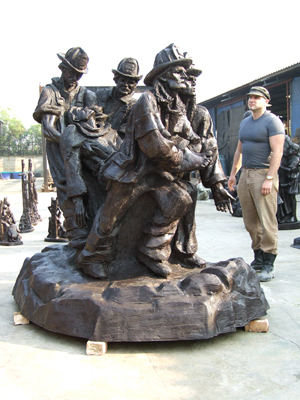If you live in the New York area, there is only day of your life which had weather that you will always remember.
That day would be September 11, 2001.
It was a dazzling sunny day. The sky was rarely bluer.
That was the day that three thousand lives ended, and the day that our lives changed forever.
This, then, is the eighteenth yahrzeit of American innocence.
On September 11, 2001, I was serving as the rabbi of a congregation in Port Washington, New York — Sands Point, to be exact — on the extreme northern tip of Long Island’s North Shore.
It was from the beach in Sands Point that I saw the second tower fall.
Three memories of that day:
The staff meeting. September 11, 2001 was a Tuesday, and as such, it was the usual day for our synagogue staff meeting. It began at eleven o’clock in the morning; by then, the true depth of the horror was unfolding.
As you might expect in an affluent North Shore synagogue, we had many members who worked in the financial district.
To be blunt, we expected that our congregation would suffer many casualties.
At the staff meeting, I said these words to my colleagues.
“There might be many deaths. As you know, our synagogue custom is to allow funerals in the sanctuary for our members.
“There is no good way to say this. We might have many requests for funerals in the sanctuary. We will simply have to deal with those requests as they come in.”
In fact, the congregation suffered no immediate losses; some relatives of congregants died that day.
It did not matter. What mattered was that I needed to find the syntax for a paragraph that I never thought I would say.
The baristas in Starbucks. The community adjacent to Port Washington, Manhasset, was greatly affected by the events of 9/11. Part of it was due to Manhasset’s demography — a significant Irish Catholic population — which meant firefighters, policemen, and traders.
On September 12, I went to the Starbucks in Manhasset, which is adjacent to the Long Island Rail Road station.
I listened to the young baristas behind the counter, whispering about the cars that had been parked in the station parking lot on the morning of September 11 — only to remain there at the end of the work day.
Unclaimed.
Silent sentinels of the worst day in American history.
“Rabbi, about my windows…” No amount of seminary and post-seminary education, no amount of collegial conversations or extra-curricular reading – could have prepared me for the question that a congregant asked me in the wake of the September 11 disaster.
“Rabbi, I live on the Upper West Side. My windows are covered with the grime that has drifted uptown since…
“I need to clean my windows, but I’ve got to believe that there are ashes of the dead in that dust. It doesn’t seem right to just have the windows cleaned.
“What do I do?”
My wondering Jew knew that Judaism views the human body with reverence. She knew that the sanctity of the body lingers after death, way after the body has been reduced to its elements. Judaism frowns on cremation, and yet the ashes of the dead are routinely buried in Jewish cemeteries.
She knows something else.
Yes, the American rabbi is often a master of ceremonies and a spiritual CEO.
And yet, the traditional role of the rabbi always wins out. That role is as teacher, with a life embedded in a wisdom tradition, as someone who hears questions and who uses a millennia-old tradition to find answers.
But my questioner, alas, has grabbed me in the synagogue lobby right after services. I am in a rush. I don’t have the time to repair to my book-laden study – much less to write to a Jewish legal authority and ask the question.
Out of somewhere, my answer came out.
“This is what I would do.
“Use a paper towel to wipe the windows clean as much as possible. Then put the paper towel in an envelope, take it to a Jewish funeral home, and ask them to bury it the next time they do a funeral.”
She nodded and thanked me for the advice – and that is precisely what she did.
It is now eighteen years later. I still do not know if I gave her the “right” answer.
But there are times when we must consult a different kind of Talmud.
It is a multi-volume tome that is located within the sacred library of the soul.
On September 11, 2001, I learned about that library.
Eighteen years later, I am still learning.
May the memories of all of them — airline passengers and crews; those in the towers; those on the ground first responders, police, firemen, and those who have died from diseases first incubated on that terrible day — be a blessing.






